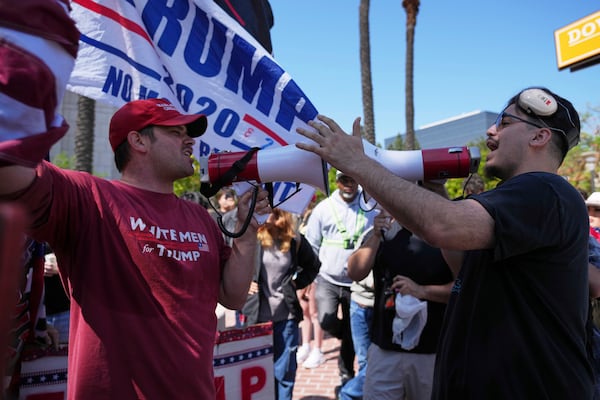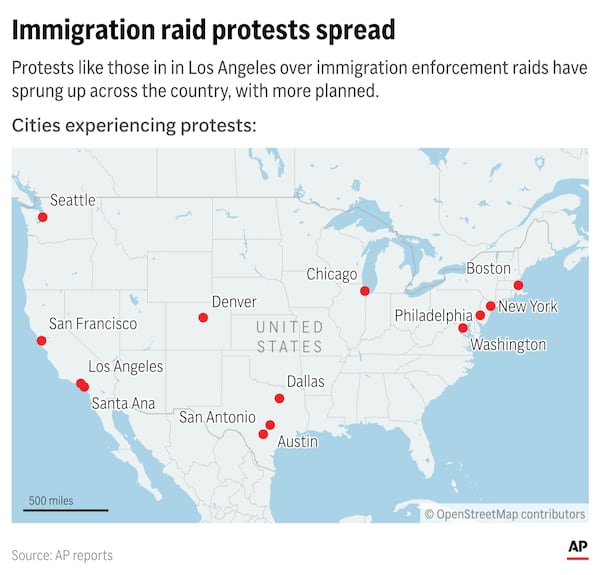LOS ANGELES (AP) — Downtown Los Angeles bustled Wednesday with dog-walkers and commuters as it returned to business as usual after the first night of curfew meant to tamp down tensions following days of protests over President Donald Trump's immigration crackdown.
There were no signs of the 700 Marines the president deployed to the city. Maj. Gen. Scott Sherman, who is overseeing Trump's troop deployment, said the Marines were undergoing civil disobedience training at a Navy facility in Orange County and it's unclear if or when they'll join the roughly 4,000 National Guard members protecting federal buildings and immigration agents making arrests in the Los Angeles area.
Those Guard troops, who were initially only tasked with protecting federal buildings and workers, temporarily detained civilians during the protests but quickly turned them over to law enforcement, Sherman told The Associated Press and another news outlet. About 500 of the Guard troops have been trained to accompany agents on immigration operations, he said.
Police said they detained more than 200 people from Tuesday through Wednesday morning — mostly for failing to disperse — but there were fewer clashes between protesters and police. That brought the total number of LA protesters who were detained or arrested since Saturday to nearly 400.
Protests over the immigration crackdown have been held in major cities throughout the U.S. in recent days. Los Angeles Mayor Karen Bass joined fellow Democratic mayors across the country Wednesday in calling for an end to the raids, which she called a provocation by the White House.
Although critics accuse Trump of manufacturing the crisis for political gain and sowing chaos, the president said on social media that Los Angeles would have been "completely obliterated" if he hadn't sent Guard members there over the weekend.
Here are some things to know about the protests, troop deployments and showdowns between local, state and federal officials:
LA police quickly enforce downtown curfew
Police wasted no time in enforcing the 8 p.m.-6 a.m. curfew for downtown Los Angeles on Tuesday, making arrests in the roughly 1-square-mile (2.5-square-kilometer) section of the sprawling city of about 4 million people. They deployed officers on horseback and used crowd-control projectiles to break up a group of hundreds demonstrating against the immigration crackdown.
Members of the National Guard stood watch behind plastic shields, but didn't appear to take part in the arrests.
On Wednesday, U.S. Attorney Bill Essayli said two people had been charged with throwing Molotov cocktails at police. No officers were hit, though police said two officers were hurt during Tuesday night's protests.
Raids spark protests elsewhere
Although the crackdown and protests have been most prominent in Los Angeles, demonstrators have been rallying against the immigration crackdown in other major cities, including Dallas and Austin, Texas, Chicago, Denver and New York, where thousands rallied and multiple arrests were made.
New York City police took 86 people into custody during protests around lower Manhattan’s Foley Square overnight Tuesday into Wednesday. Police Commissioner Jessica Tisch said the vast majority of demonstrators were peaceful.
“No Kings” rallies critical of Trump are planned nationwide Saturday to coincide with the president’s scheduled military parade in Washington.
Republican support for the crackdown
Florida Gov. Ron DeSantis, a Republican, said states “don’t have the right to just simply opt out of federal immigration law.”
In Texas, Republican Gov. Greg Abbot refused to disclose details of his mobilization of Texas National Guard troops ahead of planned protests in San Antonio on Wednesday night. And he has not said if he or the president mobilized them. In California, Trump took the rare step of deploying troops despite the objections of California Gov. Gavin Newsom, a Democrat.
“We are prepared for a peaceful demonstration, but we are also prepared if something goes south and it turns violent,” San Antonio Police Chief William McManus said.
What's behind the demonstrations?
The protests, which started Friday in downtown Los Angeles before spreading Saturday to the neighboring cities of Compton and Paramount, have been driven by anger over Trump's stepped-up enforcement of immigration laws.
The area presents a ripe target for the raids, as an estimated 10% of Los Angeles County residents aren't in the country legally.
Stephen Miller, the White House deputy chief of staff and chief architect of Trump’s immigration policies, said late last month that U.S. Immigration and Customs Enforcement should make at least 3,000 arrests a day. That would mark a dramatic increase from Jan. 20 to May 19, when the agency made an average of 656 arrests a day.
Immigrant advocates say the workers being detained, including some in the garment district, do not have criminal histories and are being denied due process. Advocates for car wash workers said that only two of 26 people detained since the weekend – 25 workers and a customer - had been located. One of unaccounted for workers was Jaslyn Hernandez's father, who was supposed to watch her graduate Wednesday.
“We have not been able to find him and it’s not fair,” Hernandez said.
Newsom clashes with Trump
Newsom has asked a court to put an emergency stop to the military helping federal immigration agents. The judge set a hearing for Thursday, giving the administration several days to continue those activities.
The change moves troops closer to engaging in law enforcement actions like deportations as Trump has promised as part of his crackdown. The Guard can temporarily detain people who attack officers, but any arrests would be made by law enforcement.
ICE said in a statement that the troops were providing security at federal facilities and protecting federal officers.
Newsom, in a public address Tuesday, called Trump’s actions the start of an “assault” on democracy.
“California may be first, but it clearly will not end here. Other states are next. Democracy is next,” he said.
Meanwhile, press freedom advocates suggest that journalists covering the protests might be being targeted. Reporters Without Borders said Wednesday that there have been at least 35 attacks on journalists — 30 from law enforcement — since the demonstrations began.
___
Associated Press writers Jim Vertuno in Austin, Texas, David Collins in New York, Jason Dearen, Jaimie Ding, Jake Offenhartz and Dorany Pineda in Los Angeles, Eliott Spagat in San Diego, Maryclaire Dale in Philadelphia and Lolita C. Baldor in Washington contributed.
Credit: AP
Credit: AP
Credit: AP
Credit: AP
Credit: AP
Credit: AP
Credit: AP
Credit: AP
Credit: AP
Credit: AP
Credit: AP
Credit: AP
Credit: AP
Credit: AP
Keep Reading
The Latest
Featured








